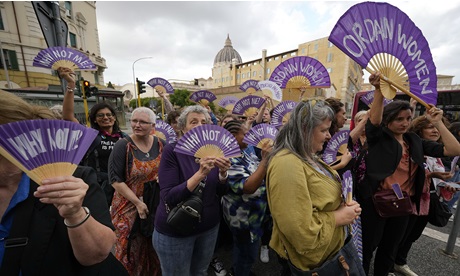Winston Churchill famously said, “Those who forget history are doomed to repeat it.” If the Catholic Church forgets history, it is simply doomed.
Pope Francis recently issued a letter “On the renewal of the study of the history of the Church.” No matter: Francis himself seems to have forgotten the history of women ordained as deacons.
When he spoke with CBS News’ Norah O’Donnell in an interview last spring, she asked if young girls would be able to become deacons someday.
He answered, “No. If it is deacons with holy orders, no. But women have always had, I would say the function of deaconesses without being deacons, right?”
Wrong.
A thousand-year tradition
For more than 1,000 years, women served as deacons (or deaconesses, depending on the language). The only person in Scripture called a deacon is St Phoebe, who traveled to Rome as an emissary of Saint Paul, carrying his Letter to the Romans.
As the church matured, women deacons were ordained during Masses, just as men deacons were.
The ordination liturgies bishops used over the centuries to ordain women to the diaconate meet the standards for sacramental ordination decreed by the 16th-century Council of Trent.
These women are named in literary documents and their names are inscribed on tombstones across the lands of early Christianity.
What happened?
The Church eventually stopped ordaining anyone to the diaconate as a permanent vocation, because the diaconate of men had become a stumbling block to ambitious priests.
By the early Middle Ages, deacons and archdeacons managed church funds and charity, and with their administrative expertise often succeeded their bishops. More than 30 popes in the early church were never ordained a priest!
The solution was a requirement that any man ordained a deacon had to be on the path to priesthood. Because women were never priests, women were ineligible for the diaconate.
Current thinking
Many delegates to the recently ended Synod on Synodality, the Vatican summit on the Church’s future, made it clear that they believed the diaconate should be opened to women.
The best they were offered was a promise that the subject was open for further study.
Yet there is a pontifical brick wall ahead. As Francis told O’Donnell, “Women are of great service as women, not as ministers. As ministers in this regard. Within the Holy Orders.”
He seems to have slammed shut the door to recovering the church’s tradition on deacons, simultaneously enabling the international walkout of women and men from Catholicism.
Yes, the Catholic population is growing in developing countries, but Church government and charity are supported by donations from nations where people of wealth and even moderate means have been educated to the baptismal equality of all persons.
They are leaving the Church.
What to do?
Francis’ own words must be applied here: “A proper sense of history can help each of us to develop a better sense of proportion and perspective in coming to understand reality as it is and not as we imagine it or would prefer reality to be.”
- First published in RNS
